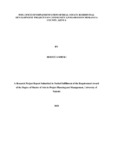| dc.contributor.author | Mbuki, Rebecca N | |
| dc.date.accessioned | 2018-10-19T11:53:08Z | |
| dc.date.available | 2018-10-19T11:53:08Z | |
| dc.date.issued | 2018 | |
| dc.identifier.citation | Master of Arts in Project Planning | en_US |
| dc.identifier.uri | http://hdl.handle.net/11295/104265 | |
| dc.description | Master of art in Project Planning and Development | en_US |
| dc.description.abstract | Real estate industry is recognized globally for taking a critical role in social, political and economic development. The real estate industry plays primal role in providing employment opportunities, enhancing income distribution and alleviating poverty all over the world. However, the real estate industry in Kenya continues to fail to fulfill this fundamental role due to a number of unique effects it possesses to the society more so in the rural area. The aim of this study was to examine the influence of implementation of Real estate residential development projects on community livelihood in Murang‟a County. The specific objectives of the study were; to examine how implementation of Real estate residential development projects influence community‟s access to health in Murang‟a county, to establish the extent to which the Real estate residential development projects influence community‟s access to education in Murang‟a county, to determine how implementation of Real estate residential development projects influence community‟s access to shelter in Murang‟a county, and to establish the extent to which the Real estate residential development projects influence community‟s access to food in Murang‟a county. The study employed a descriptive survey design and the target population for the study was the households that have had to leave their homes for the implementation of Thika greens real estate project in Murang‟a County. The target population was sampled using simple random sampling to obtain a sample of 54 Questionnaires were used to collect data which was analyzed using descriptive analysis and findings presented using tables summarized according to the common themes. The regression analysis revealed that every time real estate development projects increased by 1 unit, access to food decreased by 0.238 when all other variables are held constant. When real estate development projects increased by 1 unit, access to health decreased by 0.514when all other variables are held constant. When real estate development projects increased by 1 unit, access to education decreased by 0.247 when all other variables are held constant and when real estate development projects increased by 1 unit, access to shelter decreased by 0.603 when all other variables are held constant. The study concluded that access to food by the members displaced by real estate development project has been negatively affected as the individuals do not have the ability to produce their own food as they used to before the real estates were developed. The study recommends the implementation of legislation to the set aside of arable land and lease it out to households in an effort to ensure that there is food security and that underprivileged household can produce their own food. Further research should be carried to establish the policy reforms needed to ensure that there is set aside arable land in an effort to promote food security. | en_US |
| dc.language.iso | en | en_US |
| dc.publisher | University of Nairobi | en_US |
| dc.rights | Attribution-NonCommercial-NoDerivs 3.0 United States | * |
| dc.rights.uri | http://creativecommons.org/licenses/by-nc-nd/3.0/us/ | * |
| dc.subject | Real estate | en_US |
| dc.subject | Residential development | en_US |
| dc.title | Influence of implementation of real estate residential development projects on community livelihood in Murang’a County, Kenya | en_US |
| dc.type | Thesis | en_US |



